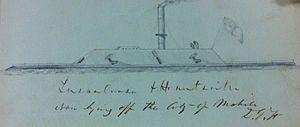CSS Huntsville facts for kids

Sketch of CSS Huntsville, Mobile, Alabama, 1864
|
|
Quick facts for kids History |
|
|---|---|
| Name | Huntsville |
| Namesake | Huntsville, Alabama |
| Ordered | May 1, 1862 |
| Builder | Confederate Naval Works at Selma |
| Launched | February 7, 1863 |
| Completed | August 1, 1863 |
| Out of service | April 12, 1865 |
| Fate | Scuttled in Spanish River to prevent capture |
| General characteristics | |
| Length | 150 or 152 ft (45.7 or 46.3 m) |
| Beam | 32 ft (9.8 m) |
| Draught | 7 ft (2.1 m) |
| Propulsion | Steam |
| Speed | 4 knots (7.4 km/h; 4.6 mph) |
| Complement | 40 |
| Armament |
|
The CSS Huntsville was a special kind of warship used by the Confederate States during the American Civil War. It was an ironclad, which means it was a ship covered in thick metal plates. These plates protected it from enemy cannon fire. The Huntsville was built in Selma, Alabama, between 1862 and 1863. It was designed to be a floating battery, meaning it carried powerful guns to defend important areas.
Building the Huntsville
The Confederate States Navy ordered the Huntsville on May 1, 1862. Its construction began at the Confederate Naval Works in Selma. The ship was launched into the water on February 7, 1863. After launching, it was moved to Mobile, Alabama, to be finished.
Armor and Engines
The Huntsville was finally ready on August 1, 1863. However, it only had some of its armor plates. These heavy metal plates came from the Shelby Iron Company and the Atlanta Rolling Mill. The ship also had problems with its engines. They were old engines taken from a river steamer. Because of these issues, the Huntsville was not fully armed. It was mainly used to guard the waters around Mobile.
Role in the Civil War
The Huntsville played a role in defending Mobile, Alabama. After the Battle of Mobile Bay on August 5, 1864, the ship managed to escape. It sailed up the Spanish River to avoid being captured. The city of Mobile continued to be held by the Confederates for another eight months. The northern part of Mobile Bay also stayed under Confederate control.
The End of the Huntsville
On April 12, 1865, the city of Mobile surrendered. To prevent the Huntsville and another ironclad, the CSS Tuscaloosa, from falling into enemy hands, they were sunk on purpose. This act is called "scuttling." The wreck of the Huntsville lies where the Spanish River meets the Mobile River. This spot is just north of Blakeley Island, near Mobile. The wreck was finally found in 1985.

